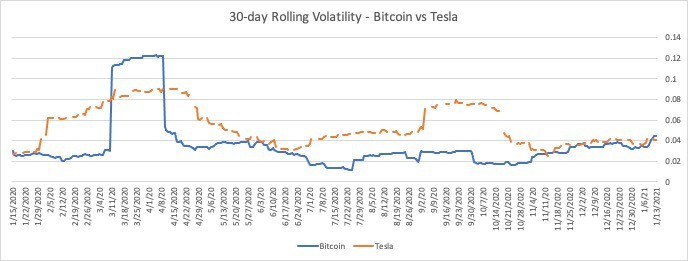The bitcoin market will continue to see price corrections and volatility, but compared to other assets that are similar in market capitalization, bitcoin is actually not that volatile despite its recent price dip, said Changpeng Zhao, co-founder and CEO of leading cryptocurrency exchange Binance, in an exclusive interview with Forkast.News.
Bitcoin hit a new all-time high (ATH) on Jan. 8, peaking at nearly US$42,000. But bitcoin prices fell more than 20% this week, from US$41,940 on Jan. 8 to US$31,698 on Jan. 12. It is currently trading just above US$38,500 as of publishing time.
Bitcoin prices: bull-run or bubble?
On bitcoin’s price growth from around US$10,000 to US$41,000 in recent months, Zhao — also popularly known as “CZ” — told Forkast.News Editor-in-Chief Angie Lau: “When that kind of price rises, a 20% correction is very, very normal, especially considering a lot of new guys coming in, buying at the new higher prices.”
“They are not the sort of what we call ‘strong hands’ holders that are in this for the long term. Many of them are for short term gains, and then as soon as they see any price drop, they rush to sell. They’re not yet the core believers.” he added.
According to Zhao, there is volatility in every market, and price discovery and mass psychology are at play.
“Everyone wants to rush in, and then the price goes up, and then somebody says, ‘Okay, now the price is high enough’, they want to cash out a bit and they start selling. Sometimes that triggers a cycle and then everyone wants to sell,” Zhao said. “We’ll continue to see corrections and volatility going forward, but compared to other similar market size market cap assets, bitcoin is actually not that volatile now…. Bitcoin’s volatility is actually lower than, for example, even Tesla’s. Tesla is going up really a lot. And then they have corrections, of course, then there’s volatility.”

What’s driving the demand for bitcoin
The total global cryptocurrency market cap now exceeds US$1 trillion, with bitcoin’s market cap at more than US$700 billion, according to crypto data aggregator CoinGecko. Bitcoin’s market cap during its recent peak surpassed that of Facebook’s, as noted by Tyler Winklevoss, co-founder of cryptocurrency exchange Gemini.
“#Bitcoin just became more valuable than $FB, next up $TSLA,” Winklevoss tweeted.
#Bitcoin just became more valuable than $FB, next up $TSLA
— Tyler Winklevoss (@tyler) January 8, 2021
Bitcoin’s price rally over the past year has drawn immense interest from institutional as well as retail investors. Binance has been seeing a “massive” number of new users and higher peak user trading volume than during the 2017-2018 bitcoin peak. “Everything is in high gear,” Zhao said.
A confluence of factors — in particular the fiscal and monetary policies by governments in response to the Covid-19 pandemic — have driven the demand for bitcoin.
“2020, that was a pretty crazy year. Covid paused all economic activity globally, and then this quantitative easing by every country,” Zhao said. “I think like 20% to 30% of the U.S. dollars were printed last year, and other countries are probably printing more than that. So basically, if you’re holding fiat currencies, your purchasing power [has been] probably devalued by 20% to 30% if you keep holding onto it.”
The bitcoin buying momentum has been fuelled by institutions such as MicroStrategy, Square, and MassMutual adding cryptocurrency to their portfolios, especially toward the end of 2020. MicroStrategy, a business intelligence firm, was one of the first-movers, announcing in August 2020 that it was adopting bitcoin as its primary treasury reserve asset. This move has led to Wall Street stalwart Morgan Stanley’s recent investment in MicroStrategy and significantly increasing the bank’s stake in and exposure to bitcoin.
“We’re also seeing a lot of new institutions coming in this round. So I think now, especially given the high profile institutions coming in the U.S., worldwide, there are many institutions coming in now,” Zhao said. “They [corporate treasurers] have to manage their corporate treasuries. They’re now allocating into bitcoin or other cryptocurrencies.”
“And then this kicks off a race — that’s the institutional race right now that we’re seeing in North America and also in the rest of the world. And then once the price starts to go up, all the retail guys flood in as well, because everyone wants a piece of the rising value.”
CZ’s predictions for bitcoin for 2021
With so much institutional capital capable of following the lead of MassMutual and Morgan Stanley, the question then is — where will bitcoin prices go from here?
Zhao expects bitcoin prices to increase by another five to 10 times this year alone. “I will put it somewhere around like US$150,000… to US$400,000-ish, in terms of bitcoin price, and the other assets [are] probably going to rise more or less with bitcoin,” he said.
Zhao’s predicted bitcoin price range follows similar calls made by JPMorgan strategists in a note to investors early this month, forecasting bitcoin prices could rise to as high as US$146,000.
Scott Minerd, global chief investment officer at macro hedge fund Guggenheim Partners, predicted late last month that bitcoin could reach as high as US$400,000. But when bitcoin prices soared above US$35,000, Minerd pulled back.
“Bitcoin’s parabolic rise is unsustainable in the near term. Vulnerable to a setback. The target technical upside of $35,000 has been exceeded. Time to take some money off the table,” Minerd said in a tweet.
Bitcoin’s parabolic rise is unsustainable in the near term. Vulnerable to a setback. The target technical upside of $35,000 has been exceeded. Time to take some money off the table.
— Scott Minerd (@ScottMinerd) January 11, 2021
See related article: New 2021 bitcoin price report forecasts risks and opportunities
All-time high volumes and Binance’s struggle to keep up
Bitcoin’s all-time highs have also led to all-time highs in traffic for the crypto exchanges handling the buy and sell transactions, and their systems have been straining to cope. Binance and other major exchanges like Coinbase and Kraken have been reporting sporadic system outages due to the surge in trading activity on their platforms.
ATH system traffic again. Systems holding up so far, not perfect, slightly higher latency in some regions. https://t.co/Jo4UIPQaL8
— CZ 🔶 Binance (@cz_binance) January 11, 2021
According to Zhao, since 2018 Binance has been working on scaling up the exchange’s infrastructure “to be ready for the next wave.” But he admits that they could do better.
“To be very honest, even today, we have expanded so much capacity, [but] we’re still struggling a little bit,” Zhao said.
“There’s a few different parts. There’s a system which [has] got to stay up when there’s peak volume, and we’re seeing 20 to 30x volumes on a 5% rise of bitcoin. So the volumes on the systems are growing much more exponentially than bitcoin prices,” he added.
“We’ve done a lot of work in the last two years, but the system’s not production-tested at those volumes.” Given the complexity of the system with many moving parts, Zhao added, “we actually had to see the new volume coming in and then adjust as we grow.”
Customer support, on the other hand, has been more difficult to scale. After all, a large portion of customer support at crypto exchanges like Binance is still managed by people.
“You can’t just hire a 10x team before the volume gets there and everybody will be bored, and that’s demoralizing. But when the volume hits, you want to hire 10x people, it doesn’t happen that quickly. So we’re struggling a little bit on that front,” Zhao said. “We’re making a lot more automated tools to help users, etc. But it’s going to take some time.”
See related article: What’s Next for CZ? Binance CEO on Getting Hacked, Being Compliant, and His Future
CZ predicts Elon Musk will buy for TESLA
The trend towards institutional adoption of cryptocurrencies, in particular bitcoin, is likely to accelerate in 2021, especially in corporate treasury. Zhao predicts that will “push the price of bitcoin and other cryptocurrencies up quite significantly.”
Zhao said he can also see Tesla’s CEO Elon Musk, who frequently tweets about cryptocurrencies, “[using] Tesla’s corporate treasury to buy first before he buys personally.”
“I wouldn’t be surprised if in a few months he announces that finally Tesla owns, I don’t know, how many bitcoins,” Zhao said. “And that’ll be really good for the industry. I think it’s going to happen sooner or later — maybe this year, maybe next year. Who knows?”
Looking to the more distant future, Zhao believes crypto will “be everywhere” in 10 to 20 years, and the “market cap will be 100x, 1,000x from where it is.”
“But of course, there’s also a chance we enter another crypto winter — I think the chances are smaller,” Zhao said. “It’s very hard to put accurate numbers on those, but we are prepared for both scenarios, so we’ll just see where the market takes us.”





